School, Shipments, and Sustainability: The Repercussions of Grace’s Delivery Habits
Media (photo of Mr. Reynolds collecting packages) provided by Alejandro Izurieta ’25
Brown boxes pile up in the lobby every day.
“There are so many faculty members here that are all constantly ordering packages from Amazon, or what have you,” says Dana Foote, the high school’s student and family coordinator. “Almost every department is receiving packages for something. Whether it is textbooks or maintenance related.”
During lunch we see new deliveries coming in, filled with books, paper, and various other school supplies. After traveling up to 7,000 miles in a couple of days, a package arrives at our doorstep. It is transported in trucks, boats, and planes. All of which release emissions with every mile.
When we look at the packages, emissions aren’t the first thing we think of. We think of the ordering, and skip to what is inside when it arrives, not everything in between. As a community that receives many packages a day, it is important to recognize the impact it has on the environment.
“We get packages all day. We get them in the morning, afternoon, and in the evening even after people leave,” claimed Eric Williams, a member of the maintenance team. The Grace High School building receives roughly forty packages a day. These packages contain a variety of contents, from school supplies to snacks.
These packages generally come in three separate deliveries from three separate trucks: Amazon, UPS, and FedEx. Each of these companies packages and ships from different places. Packages used to take longer to arrive as they came from big shipping warehouses outside of the five boroughs, but as demand increases,companies have been forced to come up with new solutions.
Amazon took more than 2 million square feet of New York City land over the summer of 2019, and this number is only growing. Factories in places like Red Hook, Brooklyn have now made it so we can receive packages faster than ever. As e-commerce shipping companies begin to expand, more gas-emitting factories open. In 2021 alone, Amazon emitted around 71.54 million metric tons of carbon, which is a 40% increase from 2019. Most of these orders are going to people’s houses, but millions are also going to schools.
Private schools around New York City cause this number to grow. Schools are reliant upon deliveries whenever they need something, not thinking twice about the impact it has on the environment. Schools need supplies, so orders are made. Oftentimes, the item is placed in a box that tends to be too big, with plastic wrap around it, and a layer of tape. It then is put on a bus, which is emitting greenhouse gasses itself, that drives around New York City, double-parks, and delivers piles of packages to each building.
The delivery process begins in a smoke-emitting factory and ends up at a building across the city. Grace is one of those buildings that have a consistent delivery schedule every day. Each part of this process releases more greenhouse gasses, and most of the time we don’t even know it. After all, we heavily rely on the shipping process.
As a community, it is important that we recognize the impact that just one part of our school is having on the environment. We rely on practices that hurt the environment, and sometimes we cannot do anything about it. When it comes to ordering packages, we should be aware of if they are actually necessary. As a school, there are a lot of supplies we need to order, but also a lot that we could live without. When making purchases that are delivered in a truck, we should reflect on if the order is really necessary.

